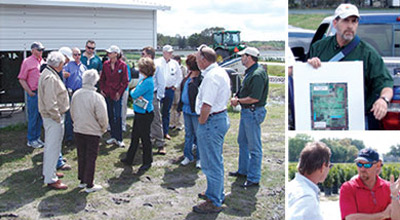 Left: The group toured the tailwater recovery system at Strawberry Red Ranch. Top right:Bill Orendorff, FARMS Program manager, describes the tailwater recovery project to the group. Bottom right: Glenn Harrell of Harrell’s Nursery, right, speaks with Bruce Wirth, District deputy executive director.
Left: The group toured the tailwater recovery system at Strawberry Red Ranch. Top right:Bill Orendorff, FARMS Program manager, describes the tailwater recovery project to the group. Bottom right: Glenn Harrell of Harrell’s Nursery, right, speaks with Bruce Wirth, District deputy executive director.
District Governing Board and staff members got a firsthand look at ways to reduce the use of groundwater for freeze protection during a recent tour of agricultural sites in Hillsborough County.
“The objective of the tour was to let the Board members learn firsthand about some alternative protection methods for freeze events,” said Lou Kavouras, deputy executive director for District Outreach, Planning & Board Services. “They were able to see some viable alternatives to groundwater pumping.”
During the January 2010 Dover/Plant City freeze event, farmers sprayed water onto their crops to protect them from the cold. This combined pumping dropped the aquifer level 60 feet and caused more than 750 dry wells for neighboring homeowners. The District is developing an action plan to prevent this situation from happening again, and the goal is to have new measures in place by the beginning of next winter.
The Board visited the Strawberry Red Ranch in Sydney, where Bill Orendorff, the District’s Facilitating Agricultural Resource Management Systems (FARMS) Program manager, introduced the Board members to farmer Adam Young. Young uses the water stored in two, three-acre tailwater recovery reservoirs to supply about half the farm’s irrigation needs. Tailwater is the water that doesn’t soak in during irrigation.
“Adam is a good farmer and very conscientious about what he does,” said Orendorff. “There were some frank give-and-take discussions between Adam and the Board members. He gave them a real sense of the farmer’s perspective.”
During the long cold snap in January, the ranch used 33.7 million gallons of water to protect the strawberries from freezing. But only 9.4 million gallons of water came from wells on the ranch. Almost 24.3 million gallons of water came from the tailwater reservoirs.
“The Board saw how a farm has been able to meet the needs for crop protection while conserving resources,” said Orendorff.
As the tour of area agricultural sites continued, the Board members saw freeze protection methods at the Oak Ridge Fish Hatchery and Harrell’s Nursery in Plant City.
“The Governing Board members had a chance to interact with some of the members of the agricultural community who are out there working the land,” said Kavouras. “It was good to get them out to see the people in our District.”
